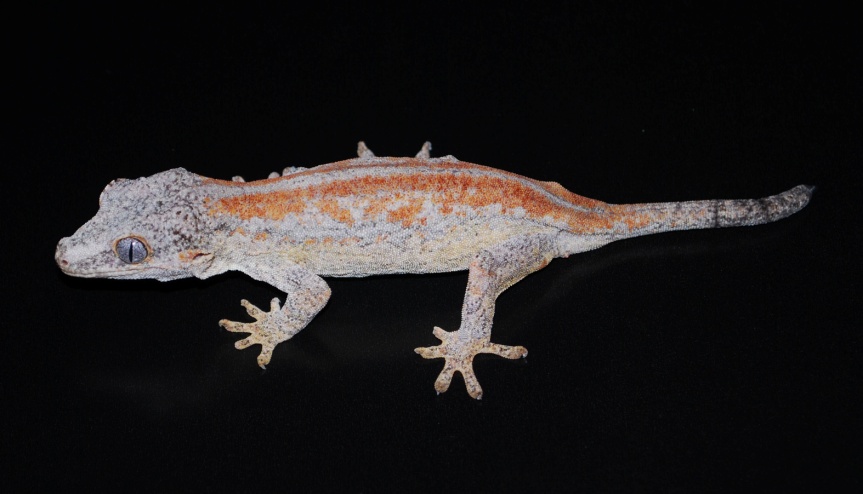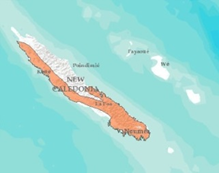New Caledonian Gargoyle Gecko
New Caledonian Gargoyle Gecko
Rhacodactylus auriculatus

 General Information
General Information
Family: Gekkonidae
Locale: Southern third of Grande Terre, New Caledonia
Habitat: Semi-arboreal; scrub habitat and forest clearings
Average Size: Average: 6-7 in; max: 4.5in SVL, 8in TL
Average Lifespan: 15 years
Activity: Nocturnal
Care Summary
Captive Care: 10 gallon tank for single animal, 15 gallon for pair, 20 gallon long for trio, prefer tanks that are taller than they are long with a screen lid for maximum circulation. Acrylic atrium with front opening door works well for breeding group. Plants (fake or real) with thin branches for climbing; avoid plants with sharp, protruding twigs. A heating pad or a low-wattage light on the outside of the cage can provide warmth, but monitor the temperature closely so they don’t become too hot.
Temperature: Thrive in temperatures ranging from 70-85° F, but never more than 85°.
Lighting: No special lighting required. If the terrarium is located near a window, natural light could be sufficient, but never place tank in direct sun.
Diet: Omnivorous; commercially available food preferred, commercial diets including Pangea Fruit Mix Complete, and Repashy Crested Gecko diet. Insects such as crickets, mealworms, flies should also be offered at least occasionally. Require Calcium/D3 supplementation in their diet, and should be dusted on insects. If commercial diet is not available, baby food (fruit flavored): apples, peaches, pears, apricots, any flavor aside from citrus fruits may be used. If using primarily baby food, mix 9 parts fruit, 1 part meat (turkey or chicken) and calcium/D3 supplement. Feed small amounts relative to their size either daily or every other day (plastic water bottle lids make good dishes for the baby food mixture). Adjust amount offered based on quantity consumed.
Breeding: Reach maturity around 40g, between 12 and 18 months, produce 4-5 clutches of 2 eggs at 4.5-6 week intervals. Females produce eggs for about 6 years. Males have hemipenal bulges and 5-7 rows preanal pores; females have no bulges and none to 3 rows of pseudopores. May exhibit TSD, but not carefully controlled.
Temperament: Timid; try to escape when handled; restrict handling to a few minutes per session. Can grow accustomed to handling over time.
Notes: Males will fight when housed together; not very sociable; drop tails readily when stressed, but will regenerate it. Hatchlings and juveniles should be housed separately or injuries may occur.
References
Bartlett, P.P., Griswold DVM, B. and Bartlett, R.D. 2001. Reptiles, Amphibians, and Invertebrates, an identification and care guide. Barron’s Educational Series, Hauppauge, NY. 279pp.
DeVosjoli, Phillippe, Repashy, Allen, and Fast, Frank. 2013. Gargoyle Geckos Advanced Visions, Inc. Vista, CA.pp145-239.
DeVosjoli, Phillippe, Fast, Frank, and Repashy, Allen. 2003. Rhacodactylus: The complete guide to their selection and care. Advanced Visions, Inc. Vista, CA. 145-239.
Henkel, Friedrich-Wilhelm and Schmidt, Wolfgang. 1995. Geckos, Biology, Husbandry, and Reproduction. Kreiger Publishing Company, Malabar, Florida. 237pp.
Seipp, R. & Henkel, F. (2000). Rhacodactylus, Biology, Natural History & Husbandry. Chimaira Buchhandelsgesellschaft mbH. Frankfurt am Main. 173pp.
Photo: Eileen Underwood
GIS Range Map: Shannon Magers
Compiled by Eileen Underwood. Updated 6/2016.
Related Projects
by students in the BGSU Herpetarium
The Herpetarium is a facility in the Department of Biological Sciences.
Bowling Green State University | Bowling Green, OH 43403-0001 | Contact BGSU Herpetarium | Campus Map
Updated: 05/13/2021 02:12PM

 General Information
General Information
